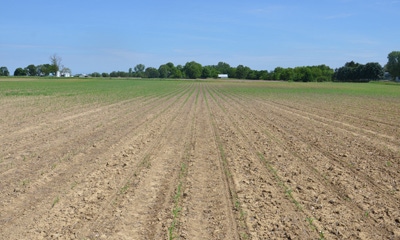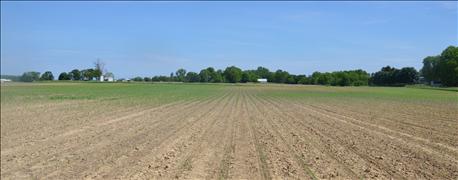
Standing at the edge of the field watching corn pollinate may seem like the wrong time to talk about whether replanting was the right decision. It may also seem mute to debate whether April 27 was the right or wrong day to plant. However, reflecting on what happens this season may help build a knowledge base for making decisions in the future.
The purpose of the Crop Watch ’16 project is to point out issues that may help you make more informed decisions, notes Dave Nanda, crops consultant for Seed Consultants Inc., sponsor of Crop Watch ’16.

MOTHER NATURE WON HERE: Cool, wet weather after planting coupled with poor drainage took its toll on this section of the Crop Watch ’16 field.
The field was planted April 27. While soil temperatures were warm and the soil was in good condition, three weeks of cool, wet weather followed. While most of the field emerged OK, this particular area where natural drainage is poor did not.
How numbers shake out
Random population checks in this part of the field determined that the population averaged 10,000 plants per acre. Stands were erratic.
The Purdue University Corn & Soybean Field Guide, prepared by the Purdue Crop Diagnostic Training and Research Center, headed by Corey Gerber, contains information that can help make replant decisions. A chart based on data collected by Emerson Nafziger, an agronomist at the University of Illinois, and updated by Bob Nielsen, Purdue Extension corn specialist, shows percent of expected yield vs. original yield potential based on planting dates and final stand counts.
At 10,000 plants per acre, for a field planted in the April 25 to April 30 time frame, the expected yield is 68% of full yield potential. If the potential was 200 bushels per acre, expected yield would be 136 bushels per acre.
While 136 bushels per acre may still seem high for 10,000 plants per acre, remember that corn can compensate to a certain extent for a missing stand, Nanda notes. However, it doesn’t have the ability to compensate like soybeans.
New math
The area could not be replanted until May 25. The farmer spotted in seed in new rows next to existing rows where stands were weak. If he obtained a stand of 32,000 plants planted on May 25, yield potential is 86% of original potential, or 172 bushels per acre. Obviously, a 36-bushel advantage more than covers replanting costs.
Note, however, that if the stand had been impacted by weather on the second planting, loss of yield potential would have been even greater. At 20,000 plants, he would expect about 160 bushels per acre.
REPLANT IMPROVES YIELD POTENTIAL: Less-than-ideal weather and poor drainage created thin stands on this section of the Crop Watch ’16 field (left), which was replanted on May 25 (right). The existing rows were left intact.
About the Author(s)
You May Also Like




